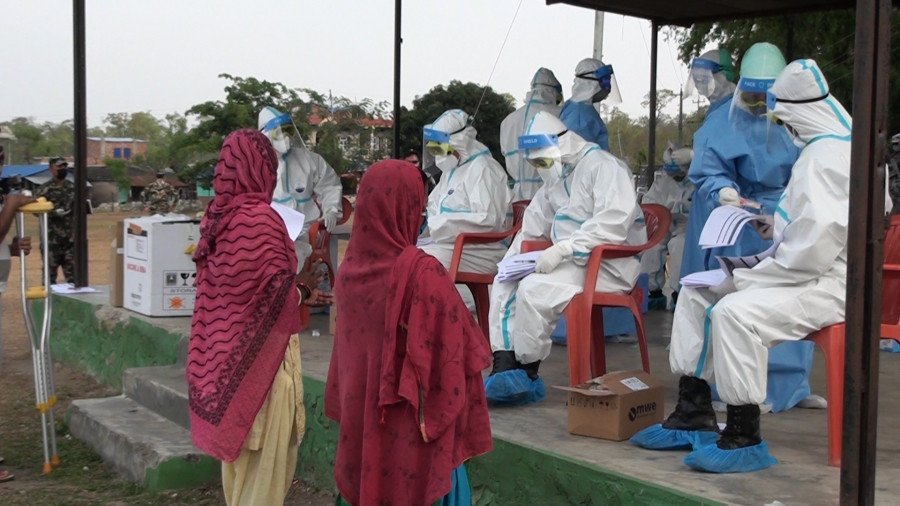Health
Covid-19 cases expected to surge in villages in next two weeks
Experts urge authorities to prepare quarantine, isolation facilities in villages and oxygen supply in district hospitals as they expect returnees to villages for Dashain to transmit the virus.
Arjun Poudel
Of the 8,248 swab samples tested in the last 24 hours only 1,954 people tested coronavirus positive. The number of people testing positive was even lower on Tuesday—570— as only 2,725 had been tested.
By contrast on October 21 a record 5,743 had tested positive.
The recent decline in new cases are not only due to the Dashain holidays but also because the government had halted free tests and contact tracing. After severe backlash from various quarters including from within the ruling Nepal Communist Party, the government has directed the state run hospitals to charge only those who can pay.
However, the Ministry of Health and Population has not rolled back the decision of not performing free tests and contact tracing. The ministry has instead decided to stop daily press briefing from Thursday onwards and to make it twice weekly.
Officials and public health experts have warned that the decision of not performing tests and contact tracing will be costly for the nation in the coming days.
As thousands of people have gone to their villages during Dashain to celebrate the festival with their families from the Covid-19 hotspots like Kathmandu Valley, more people residing in villages across the country are expected to get infected in the coming days.
“We are anticipating an exponential rise in the new cases in the coming days, as the district adjoins Kathmandu and a lot of people have returned to their villages for Dashain,” Dr Sunita KC medical superintendent at Trishuli Hospital in Nuwakot, told the Post. “The number of serious cases will also rise, as the number of infections rises.”
However, the hospital has limited capacity in terms of beds, human resources and other resources to deal with the possible influx of the coronavirus patients.
Public health experts say it takes two weeks to four weeks for a widespread outbreak of the coronavirus after some infected people transmit the virus within a specific area.
Dr Baburam Marasini, former director at the Epidemiology and Disease Control Division said that a new wave of coronavirus infection could start in hill districts after a month, as authorities concerned have not taken any measures to prevent the disaster.
Public health experts have also urged for restrictions in movement within and from hotspots like in the Kathmandu Valley, but authorities concerned allowed people to freely go to their villages.
“Even if authorities have stopped testing and contact tracing in the major hotspots like in the Kathmandu Valley, they should continue in the villages, where the disease has not yet spread widely,” Dr Prabhat Adhikari, infectious disease and critical care expert, told the Post. “The only way to prevent looming disaster in the villages is to curb mobility, increase tests and make contact tracing effective.”
According to Adhikari, people, who went to villages from the hotspots can be tracked by tracking people’s mobile phones with the help of telephone companies and local governments.
“Authorities have to curb the mobility of those people and test to lessen risks,” he said.
While district hospitals like the one in Nuwakot are anticipating a surge in cases, the ones in Kathmandu are already overwhelmed.
Of the 62 Covid-19 patients being treated at Sukraraj Tropical and Infectious Disease Hospital in Kathmandu on Wednesday, 52 were in critical condition. Health conditions of the remaining 10 were moderate but they needed oxygen therapy.
“Our hospital is only of 50 beds capacity but we are adjusting additional 12 patients,” Dr Sagar Rajbhandari, director at the hospital, told the Post. “We are getting calls from various hospitals in the Valley and from the districts for beds, but we do not have any left.”
The government disregarded the experts' warnings and defied science, facts and truths since the beginning.
The World Health Organization has said that many countries and cities that have followed the science, suppressed the virus and minimised the number of deaths.
“When leaders act quickly and deliberately, the virus can be suppressed,” Dr Tedros Adhanom Ghebreyesus, director general of the UN health agency said. “But when there has been political division at the national level; where there has been blatant disrespect for science and health professionals, confusion has spread and cases and deaths have mounted.”
Instead of following the science, listening to the expert’s scientific suggestions , authorities give up the fight against the pandemic in Nepal. The four-month-long lockdown from March 24 to July 21 was not sufficiently used to ramp up preparations for rise in cases and Prime Minister KP Sharma Oli lead the chorus of those saying that Nepalis would not suffer from the pandemic because of their immunity.
Public health experts, however, are worried about the further spread of the virus. As of Wednesday 162,354 people have been infected across the country with 887 deaths.
“I am worried about the possible loss of lives in the hill districts after a month,” said Marasini. “Authorities should start preparing quarantines to keep people who came in close contact with the infected, isolation places for the infected people and arrange for oxygen supply at least in district hospitals.”
Most health facilities in the districts even lack ambulances to carry patients infected with highly pathogenic diseases like coronavirus.
Meanwhile, officials at the Health Ministry concede that the coming days will be more challenging, as the more people in villages could be infected.
“So far our hospitals in big cities and in Kathmandu Valley have been overwhelmed,” said Dr Samir Kumar Adhikari. “We are worried about the possible worst case scenario in the coming days, as we do not have sufficient beds or health facilities in villages.”




 6.1°C Kathmandu
6.1°C Kathmandu














